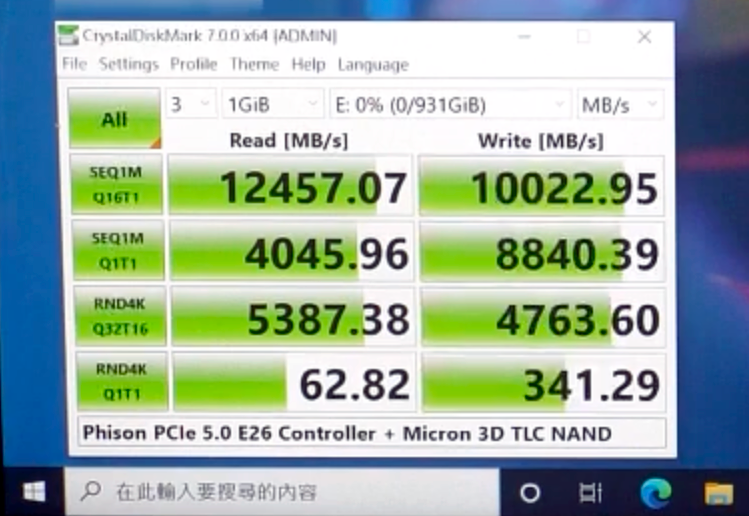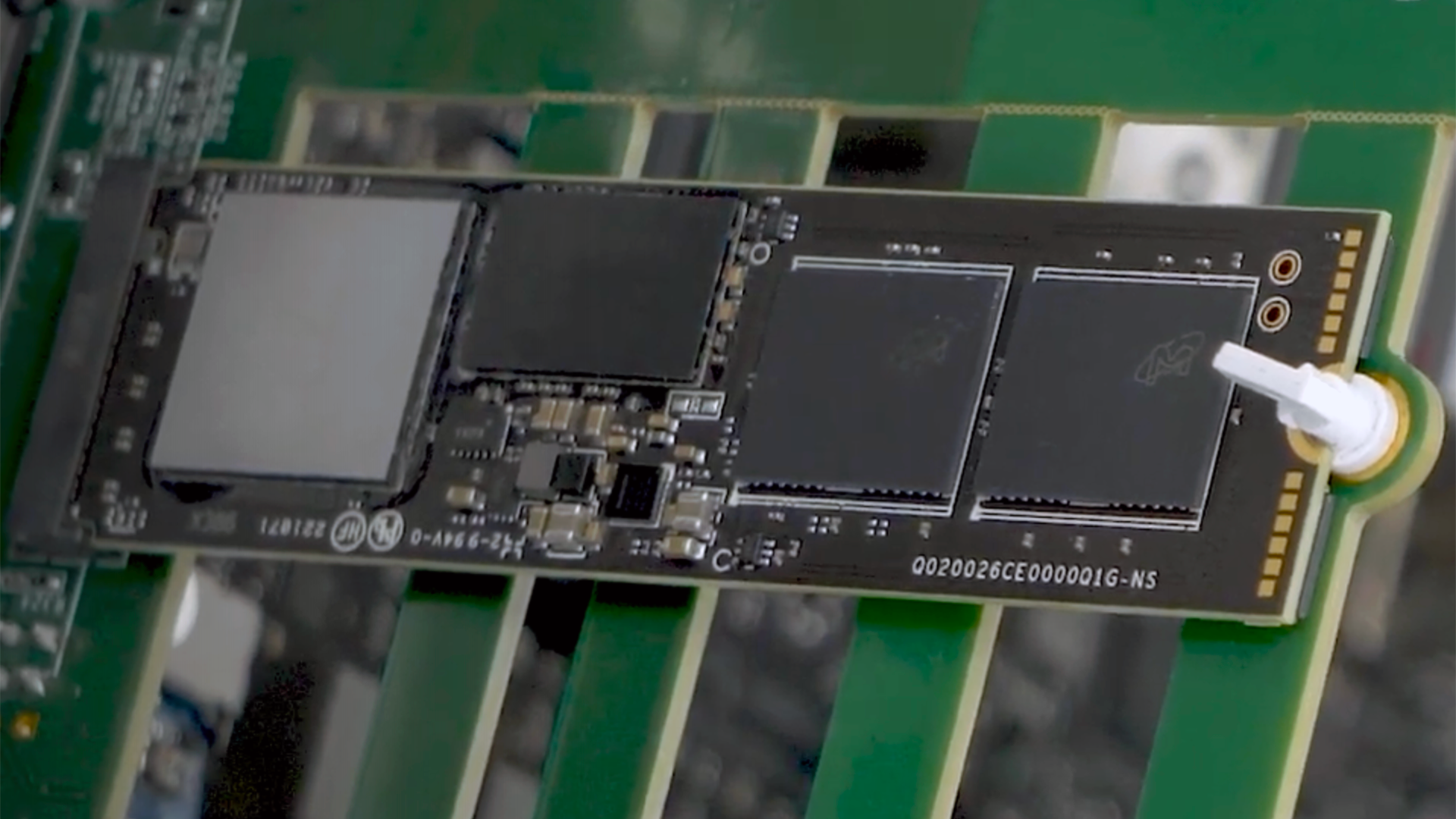Phison Demos M.2 PCIe 5.0 x4 SSD: Up to 12GBps Reads
Phison this week showcased its next-generation PS5026-E26 SSD platform with a PCIe 5.0 x4 interface aimed at high-performance desktops and enterprise applications. Based on the demonstration, the new drives will radically improve the sequential read and write performance.
Because of the PCIe 5.0 x4 interface that offers raw bandwidth of up to 15.8 GB/s in each direction, solid-state drives featuring this interface are projected to increase sequential read and write speeds of SSDs drastically. Other improvements include higher capacities thanks to new 3D NAND devices, enhanced reliability, and new features enabled by next-generation controllers.
Phison's reference SSD featuring its PS5026-E26 controller and 1TB of Micron's 3D TLC memory provides a maximum sequential read speed of up to 12,457 MB/s and a maximum sequential write speed of up to 10,023 MB/s (according to CrystalDiskMark), which by far exceeds capabilities of today's best SSDs. As for random performance, the drive can provide up to 1.31 million 4K read IOPS and up to 1.16 million 4K read IOPS, which is higher than the vast majority of client PCIe 4.0 x4 drives.
Phison's 1st Generation PCIe Gen5 E26 SSD controller is powered by Arm's Cortex-R5 cores accompanied by special-purpose accelerators from the company's CoXProcessor 2.0 family. The controller can work with all contemporary and future types of 3D NAND memory featuring ONFI 5.x and Toggle 5.x interfaces at up to 2400 MT/s data transfer speeds. Since Phison positions its PS5026-E26 both for client and enterprise usage, the controller also supports functionality like PCIe Dual Port connectivity for U.3 SSDs, single root input/output virtualization (SR-IOV), and zone namespaces (ZNS).
Phison did not reveal when the first client SSDs based on the PS5026-E26 controllers will be available commercially. However, last year it implied that the first drives using its PCIe 5.0 x4 platform would hit the market in the second half of 2022, which probably means late 2022. These SSDs should come to market in the same time frame as the Zen 4-powered AMD Ryzen 7000 processors.
Get Tom's Hardware's best news and in-depth reviews, straight to your inbox.

Anton Shilov is a contributing writer at Tom’s Hardware. Over the past couple of decades, he has covered everything from CPUs and GPUs to supercomputers and from modern process technologies and latest fab tools to high-tech industry trends.
-
wifiburger worthless, pcie3 to pcie4 nvme didn't do anything for mostReply
The only thing that it did for me is increase price and lower the total drive capacity
Instead of chasing crap speeds they should focus on price and capacity because regular SSD are getting more and more attractive these days and those at 600mb/s :ROFLMAO:
excuse me for not giving 0 f about 1tb doing 10Gb/s when 4tb ssd 600mb/s is half price -
kiniku For most of us, the bottom number impacts end user "experience" more than any other: RND4K Q1T1 speed. And in that measure it's really no different from a 3.0 SSD.Reply -
jp7189 Reply
I would argue that sequential q1t1 has an impact on many consumer applications as well. Also since this controller will target enterprise drives the high queue depth metrics are meaningful to that segment.kiniku said:For most of us, the bottom number impacts end user "experience" more than any other: RND4K Q1T1 speed. And in that measure it's really no different from a 3.0 SSD. -
LuxZg Replykiniku said:For most of us, the bottom number impacts end user "experience" more than any other: RND4K Q1T1 speed. And in that measure it's really no different from a 3.0 SSD.
You actually made me turn on PC and check speed of my ancient (6 years old this week!) SM951 ...
Rough speedup for this sample PCIe 5.0 drive in parentheses.
My reads:
2156 (6x)
1448 (3x)
1227 (4x)
50 (20%)
Writes:
1226 (9x)
1185 (8x)
233 (20x?)
143 (2.5x)
Unsure what's with low write at RAN4K Q32T16 for my drive, but let's disregard that (despite result being vwry repeatable).
Anyway, I agree that worst case vs best case isn't all that good... 20% read speedup (vs 600% sequential) and 250% write speedup (vs 9x sequential).
And I agree that probably moves something like Word startup from 2s to 1.8s.
But we have to keep our eyes on new tech/features, like DirectStorage and AMDs Smart Storage. So I will keep my judgment until some real world tests arrive, like game loading times, if there's any difference while playing, and so on.
I really just need 512GB, but I wouldn't mind 1TB. What I can say, there's no 4TB drives for half the price :p Where I live 1TB jumps roughly 2x in price for PCIe 4.0 drive vs 3.0. But a 4TB PCIe 3.0 NVMe drive is still almost 4x the price of that 1TB 4.0 drive ! So yeah, if 5.0 drives are another 2x increase vs 4.0 I'll skip. If it is roughly still just 2x vs 3.0 then it's a buy. After all, when I get one, I'm unlikely to upgrade next 6 years again ;D -
InvalidError Reply
Because realizing the benefits of massively increased bandwidth and reduced latency is going to require a major overhaul of how most software loads stuff. Typical software reads data from storage at the point of use, then waits for the read to return before processing the data until it reaches the next point where it needs to read more data, wait, then process that, rinse and repeat. To leverage NVMe's full capabilities, software needs to be rewritten to load everything it can concurrently ahead of processing so it doesn't get stalled waiting on reads.wifiburger said:worthless, pcie3 to pcie4 nvme didn't do anything for most
Most software developers likely won't bother re-arranging their code to accommodate pervasively threaded and pipelined asynchronous loading beyond what is absolutely essential to user experience. -
mdd1963 WHen all is said and done, with the upgrade from PCI-e 4.0 drives, I predict Windows will boot ~1/2 second quicker (15 seconds vice 15.5!), and, games will launch in 20 seconds vs. 21 seconds... :)Reply -
escksu You will only experience the speed in sequential read/write situations. Serial nature of I/O means your won't benefit much from read/write of small files. This unfortunately is typical of end-user environment.Reply
Try this: copy 1 x 1GB file and 1000 x 1MB file, despite the same overall size, 1000 x 1MB takes way longer. It only copies 1 file at a time (serial nature of I/O) and you will probably see 10-20MB/s speed... -
InvalidError Reply
In the case of games and likely some software with a boatload of plugins, there would be significant potential performance benefits to parallelizing loads to whatever extent dependencies will allow and prioritizing them accordingly to minimize bottlenecks. While IO to the raw block device may be serial, a lot of the processing that happens afterwards doesn't need to be and that is where the biggest bottleneck currently is.escksu said:You will only experience the speed in sequential read/write situations. Serial nature of I/O means your won't benefit much from read/write of small files. This unfortunately is typical of end-user environment. -
LuxZg All this is quite true. But in my case biggest lag I have is when logging into PC, so after boot, when several things auto-load and I start clicking and opening all stuff I'm gonna use. That situation doesn't need rewrites or optimizations, and speedy I/O matters. OK, so I may still not notice much difference between individual PCIe generations, but I believe a jump from first gen NVMe drive to something like this engineering sample would still be noticable.Reply
As for rewrites - those will barely happen even in biggest of apps and suites, but I do expect future game development to take this into consideration (due to consoles supporting it already).
Also, you will slowly but surely stop using those options like "don't update in background while I play", so you will less often be forced to endure the whole "torture" cycle before starting to game. It's just all too often that I start PC that then needs an update, then start Steam that needs to update, then when it starts dozen games need to update, including one I want to play, and then you actually start a game, load the save and... time is up and you can shut it all down. Hopefully with background updates that will happen less, and when it does happen, should be faster. Letting stuff start and update/install at once on fast NVMe should improve experience quite a bit. Sure it's not something you do all day long, but boy does it feel like that sometimes ;D

